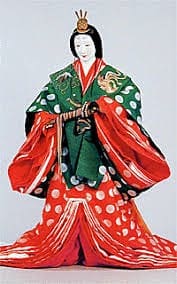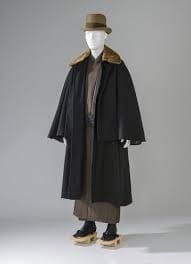Introduction to Japanese Fashion
Traditional Japanese fashion represents a long-standing history of traditional culture. From each of its ancient era , fashion here has created a whole new and different world., from encompassing colour palettes developed in the Heian period ,silhouettes adopted from Tang Dynasty clothing and cultural traditions, motifs taken from Japanese culture nature and traditional literature , and styles of wearing primarily fully-developed by the end of the edo period .

Three most important eras in Japanese fashion
Heian era
Meiji era
Taisho era
-
Heian era (792-1192)


The Heian period is regarded as one of the great periods of artistic and cultural development in Japan.During this period before the birth of kimono, a beautiful costume culture blossomed.These were some unique garments like a formal uniform with round-collared jacket , the less formal, round-collared kariginu, the women’s layered costumes and inner pleated trousers.
During this era the concept of the hidden body remained, with ideologies suggesting that the clothes served as “protection from the evil spirits and outward manifestation of a social rank.
Costumes in this period were tailored from woven silk. They were composed of numerous layers worn one over the other. It takes quite a bit of knowledge and experience to dress a person .
About Junihitoe



The most well-known clothing of the Heian period is the junihitoe, or ‘twelve layered robe’, worn by the highest-ranked ladies of the Imperial Court.This was the highest formal wear for a woman, and could easily weigh more than thirty or forty pounds in the wintertime jūnihitoe each layer temporarily belted in place until the next layer is carefully draped over it.
The woman’s jūnihitoe sports a long pleated half skirt draped from the hips and trailing out to the back, and the men’s under robe has a long narrow trains trailing behind the personJunihitoe robes were plain, flat silk, as brocades and other kinds of figured silk could only be worn if one had imperial permission.Surprisingly, each layer of a junihitoe is the same size , and there were no smaller size robes .
Heian era Junihitoe clothing paid special attention to colour symbolism, with the layered colour combinations of women’s clothing known as kasane no irome.
Introduction to kimono in Japanese fashion


During Heian era japan’s most iconic garment, the kimono, was introduced.It was introduced with a method known as straight line cut method.It involves cutting pieces of fabric in straight line and sewing them together This made it easy to make, wear and store, giving rise to its popularity. After its introduction the sense of fashion gradually changed in Heian period. After its introduction and popularity , many different types of kimono evolved in later eras .During the later ages the symbolic meaning of the kimono shifted from a reflection of social class to a reflection of self, allowing people to incorporate their own tastes and individualize their outfit.
Meiji Era (1868-1912)



It was during Meiji period (1868-1912) the Japanese people were first widely exposed to western influences which represents one of the most remarkable transformations in Japanese history of fashion.
During this Era the country emerged as a modern, industrialized and powerful nation, taking influence from the western culture. The japanese have enthusiastically borrowed and adopted the style and practices from western countries.Nobles and members of the military class were permitted to wear luxurious, patterned silks, and elaborate brocades and to adorn themselves with fancy sashes.In 1871, the Meiji Emperor Order that the western clothing must be worn by high officials during business hours or official function.After that women also started wearing western dress in public but changed into traditional clothing at home.
Japanese men clothing in this era

It was first adopted for men’s military uniforms, with French and British style uniforms designed for the army and navy. The government workers, such as policemen, railroad workers, and postal carriers, were required to wear Western male suits.
Japanese women clothing in this era

The only women who still wore Western fashion were the high nobility and wives of officials in foreign office.They adopted dress such as coats, shawls, veils and jewelry but it was still common for women to wear kimono, increasingly paired with contrasting accessories like hats, scarves, gloves, umbrellas and handbags.Women in the Changing Fashions, From the Kimono of the Early Edo Period to the Western Fashions of the Meiji era.
A Japanese man and woman (holding a small child) facing the camera, with serious expressions on their faces, each wearing circa 1900s, Meiji-era clothing, the man in a woolen cap, jacket, and trousers ensemble, the woman and child wearing yukatas or kimonos.
Taisho Era (1912-1926)


As the Taisho empire continued, modern living thrived. The dawn of radio, magazines and cinema inspired fresh styles such as decorated collars and new patterns. The West and the East began to share trends and by the end of the 1920s favoring a glamorous slim line with vertical draping in gowns, robes and dresses. However, the majority of adult Japanese women still favored traditional dress, with some experimenting with modern hairstyles.Meanwhile, men became increasingly accustomed to wearing coats, suits and caps.
Additionally, changes occurred in the way the kimono was worn. There was shortening in the extra lengths and modifications in knots.
Japan’s increased exposure to Western culture influenced kimono patterns and their colors in various ways. First, the patterns are no longer only of natural beauty, like trees and birds, but are often abstract designs. Second, the colors of the fabrics are no longer necessarily related to the age of the person who wears them.
Also there are now two-pieced kimonos that are as easy to wear as blouses and skirts. Even “ready-to-wear” tied obi are available to put on like sash belts.



Conclusion
From ancient Japanese era till now Japan has seen numerous change in fashion . some adapted from western culture and some giving a modern touch to their traditional clothing . There was always a newness in its fashion and has produce a new road to today’s modern fashion as many famous designers take inspiration from ancient Japanese fashion to produce their new collection.
Hope you enjoyed the article .
Article by Arsh Kumar Gupta
Instagram : @arshgupta47

